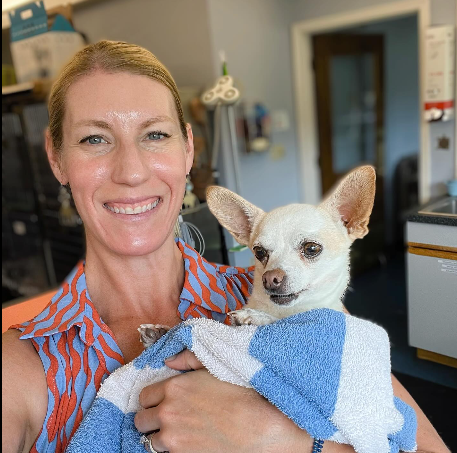When handled carefully, safflower oil—which is frequently included in human diets due to its health benefits—can help dogs as well. This oil, which was derived from safflower plant seeds, is high in linoleic acid and other omega-6 fatty acids. These fats are essential for maintaining the health of a dog’s skin since they help create a glossy coat and may also help treat dermatitis or dry, itchy skin.
Moderation is essential when adding safflower oil to a dog’s diet. Omega-6 fatty acids in excess can throw off the equilibrium with omega-3 fatty acids and cause inflammation. For a dog to have the best possible health, these fatty acids must be kept in the right proportion. Seeking advice from a veterinarian regarding the right dosage and taking into account a balanced diet that naturally
Furthermore, because safflower oil is free of trans fats and has a low saturated fat content, it might be better for dogs who are allergic to other oils or sensitive to other oils. If you’re thinking of giving your dog safflower oil as a food supplement, make sure it’s premium, cold-pressed oil free of chemicals and preservatives. It’s advised to introduce safflower oil gradually and watch your dog’s reaction for any negative effects, just like with any dietary change.
ABOUT SAFFLOWER OIL
Safflower oil is a type of vegetable oil that is derived from the seeds of the safflower plant and is well-known for its adaptability and possible health advantages. Because of its high nutritional content and abundance of polyunsaturated fats, particularly omega-6 fatty acids like linoleic acid, it is frequently included in human diets. However, when administered carefully, it also has benefits for dogs.
Linoleic acid, the major ingredient in safflower oil, is an important fatty acid that is vital for sustaining a dog’s healthy skin and shiny hair. This oil is known to improve healthier skin conditions by reducing dry, itchy skin or dermatitis in dogs.
While safflower oil can have advantages, it’s crucial to remember that moderation and proper use are the keys to its effectiveness. Overconsumption may cause inflammation by upsetting the equilibrium between omega-6 and omega-3 fatty acids. Before adding safflower oil to a dog’s diet, it is best to speak with a veterinarian to figure out the right amount and make sure it fits the dog’s individual needs. For optimal results, it is also advised to choose premium safflower oil free of additives and preservatives.
Is Safflower Oil Really Safe For Your Dog?
Safflower oil safety for dogs is contingent upon a number of things. Because of its omega-6 fatty acids, it may be beneficial, but there are a few things to keep in mind while determining its safety.
When handled carefully, safflower oil can be a beneficial addition to a dog’s diet. It has important fatty acids in it that support healthy skin and a glossy coat. The secret, though, is moderation. Overconsumption of omega-6 fatty acids may upset the equilibrium with omega-3 fatty acids and cause inflammation.
It is essential to see a veterinarian before introducing safflower oil or Onions into a dog’s diet. This guarantees that it corresponds with their unique health requirements and establishes the suitable dosage. It’s possible that some dogs get enough omega-6 from their normal diet and don’t need extra supplements.
Moreover, the oil’s quality is important. Select premium, additive-free safflower oil, and add it gradually while keeping an eye out for any negative responses. In certain dogs, allergies or sensitivities to safflower oil can result in skin responses or intestinal problems.
.
BENEFITS OF SAFFLOWER OIL FOR your DOGS
Dogs may benefit from safflower oil in a number of ways, especially because it has a high concentration of omega-6 fatty acids, namely linoleic acid. For dogs’ skin and coat health, these fatty acids are essential. By adding safflower oil to their food, you can help them with dermatitis and dry, itchy skin while also encouraging a shiny, healthy coat.
Furthermore, because safflower oil has no trans fats and has a comparatively low saturated fat level, it may be a better choice for dogs that have allergies or sensitivities to other oils. Due to its adaptability, it may be used in a variety of ways, such as homemade dog food recipes, as a dietary supplement to keep a shiny coat, or to support skin health.
High in Omega-6 Fatty Acids: Dogs with shiny coats and healthy skin benefit from the omega-6 fatty acid linoleic acid found in safflower oil.
Benefits to Skin Health: Manages dermatitis and dry, itchy skin, leading to a healthier skin state.
Support for Immune Function: When combined with omega-3 fatty acids, the omega-6 fatty acids in safflower oil help the body’s immunological response and promote a healthy inflammatory system.
An Alternative for Sensitive Dogs: It has less trans fat and less saturated fat, so it might be a good choice for dogs who have allergies to certain oils or sensitivity to other oils.
Adaptable Uses: May be added to homemade dog food recipes or used as a nutritional supplement to help maintain healthy skin and coat. For best results, moderation and veterinary advice are suggested.
Risks OF SAFFLOWER OIL FOR DOGS
While safflower oil can offer benefits, there are potential risks associated with its use for dogs:
Imbalance of Fatty Acids: Consuming too much safflower oil may throw off the equilibrium between omega-3 and omega-6 fatty acids, which may cause inflammation.
Allergic responses: Dogs that are sensitive to safflower oil may experience allergic responses, which can cause skin or intestinal disorders.
Superfluous Supplementation: Dogs who get enough omega-6 from their normal diet might not need extra supplements, which could lead to an imbalance in important fatty acids.
Quality and Dosage: Improper dosage or low-quality safflower oil may have negative consequences. Selecting premium oil and adding it gradually is essential.
Consulting a veterinarian before introducing safflower oil into a dog’s diet is recommended. This helps ensure it aligns with the dog’s specific health needs and determines the appropriate dosage to mitigate potential risks.
How To Give Your Dog Safflower Oil
It is advised to speak with a veterinarian before adding safflower oil to a dog’s diet. This makes it easier to make sure it meets the particular health requirements of the dog and establishes the right dosage to reduce any hazards. It’s important to introduce safflower oil to your dog gradually and in moderation. It is advisable to begin with lower doses and increase them gradually over time to monitor tolerance and potential negative responses. Larger breeds can start with a teaspoon, but smaller dogs usually start with half a teaspoon. Before adding safflower oil to your dog’s diet, it’s best to speak with a veterinarian to figure out the right amount for their size, health, and dietary needs.
Adding safflower oil to your dog’s normal diet is one popular approach. Make sure the oil is well spread throughout the dish; it’s frequently more well-received when combined with liquids or moist food. Use only premium, cold-pressed safflower oil that hasn’t had any additives or preservatives added. This makes sure your dog gets the most out of everything without getting any extra bad stuff.
It’s important to watch your dog’s response. Keep an eye out for any indications of negative effects, such as stomach problems, skin responses, or behavioral changes. If your dog reacts negatively to the medication, stop using it and see your veterinarian. Making necessary dosage adjustments and keeping an eye on their reaction will assist guarantee that your pet receives safflower oil in a safe and healthful manner.
NUTRIENTS IN SAFFLOWER OIL
Numerous vital elements, including omega-6 fatty acids, particularly linoleic acid, are abundant in safflower oil. This kind of fatty acid is essential for a number of physiological processes in a dog’s body, especially those that support healthy skin and a glossy coat. Safflower oil also has vitamin E, an antioxidant that promotes a dog’s general health and helps shield cells from harm. This vitamin can improve a dog’s coat shine and is important for keeping healthy skin. But it’s important to make sure that the ratio of fatty acids—particularly omega-6—matches the dog’s nutritional needs because too much of one type of fatty acid can cause imbalances and ensuing health problems.
In order to obtain the nutritional benefits of safflower oil without disturbing the appropriate balance of key elements, moderation and consideration of the dog’s total diet are crucial. Seeking advice from a veterinarian can help determine the right dosage and usage for a dog’s individual medical requirements.
Conclusion
Because safflower oil is rich in vital nutrients including omega-6 fatty acids and vitamin E, it may be beneficial for dogs, especially when it comes to promoting healthy skin and a shiny coat. When adding it to a dog’s diet, moderation and caution are crucial to avoid any possible imbalances in important fatty acids that could cause health issues. Before using safflower oil, it is best to speak with a veterinarian to establish how best to use it and make sure it is in line with your dog’s unique health needs. For safe and effective use, it’s also important to use premium safflower oil free of preservatives and additives and to observe your dog’s reaction. A careful, well-rounded approach that supports a dog’s total diet and health demands is essential to maximizing the nutritional benefits of safflower oil and ultimately enhancing their vitality and well-being.
Po

Dr. Allison Kramer is a seasoned veterinarian with a Master’s degree in Animal Behavior and over 10 years of experience specializing in canine health and behavior. Her expertise in positive reinforcement training and holistic care enhances the well-being of dogs and fosters strong pet-owner relationships. For expert advice and valuable insights, follow Dr. Kramer on Instagram @dr.allisonkramer.





